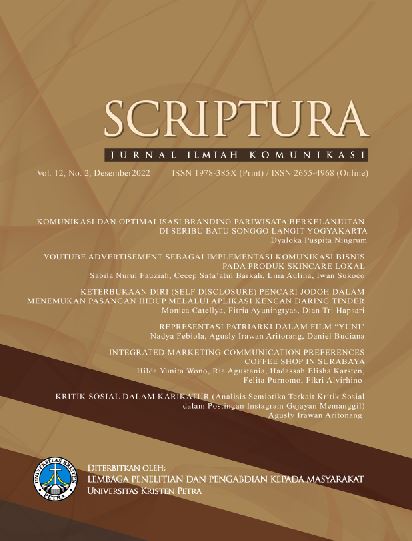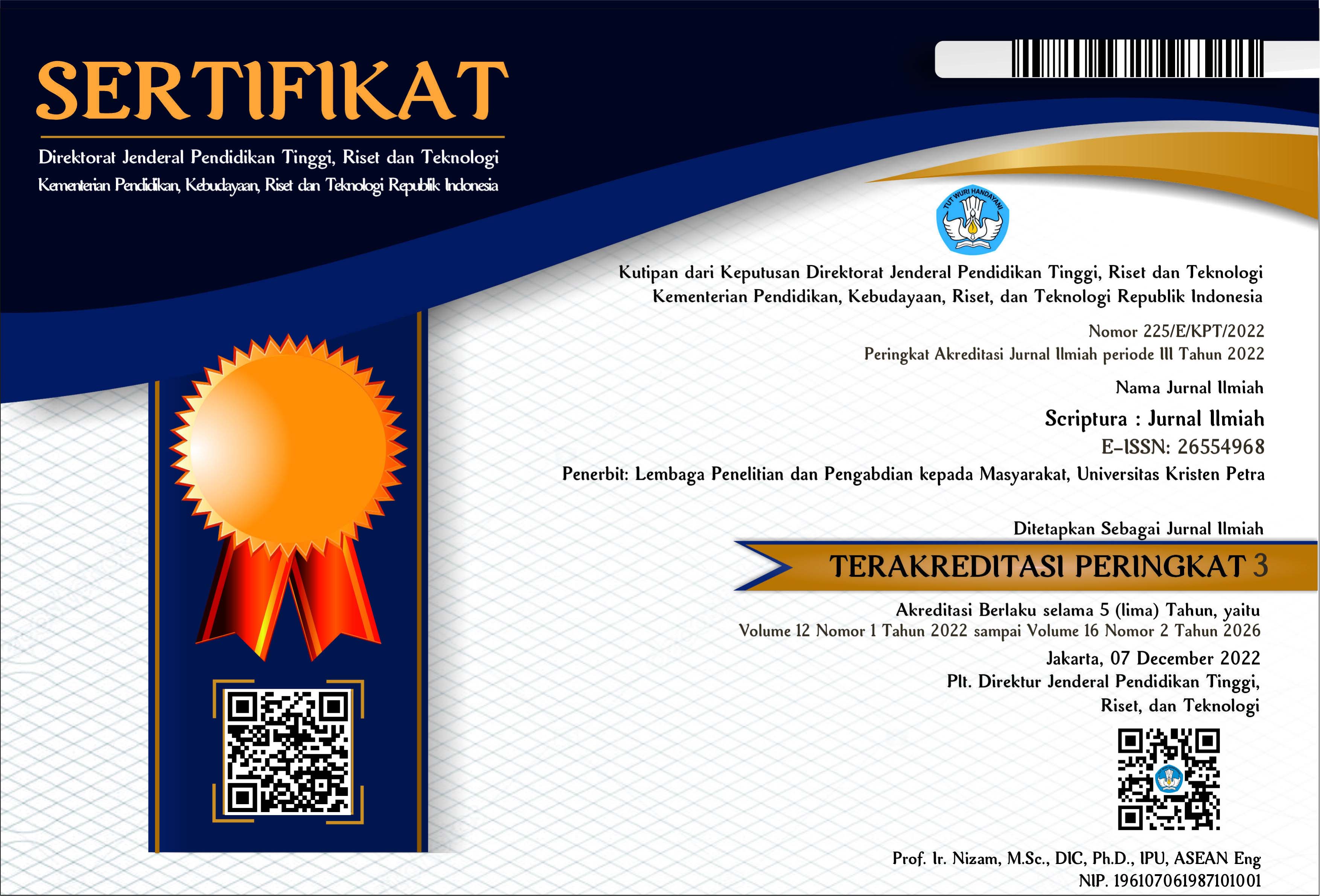KETERBUKAAN DIRI (SELF DISCLOSURE) PENCARI JODOH DALAM MENEMUKAN PASANGAN HIDUP MELALUI APLIKASI KENCAN DARING TINDER
 :
:
https://doi.org/10.9744/scriptura.12.2.92-99
Keywords:
Self Disclosure, Self Disclosure Theory, Tinder AppAbstract
Currently, Tinder is in great demand because it is proven by the presence of several couples who have made it to the stage of marriage. Factors of tension, anxiety, anxiety, shyness to an unattractive appearance make a person reluctant to do self-disclosure when having a face-to-face relationship. This research aims to find out how the motives, experiences, and meaning of self disclosure of mate seekers in finding a life partner through the Tinder application. This research uses a qualitative method with phenomenological approach. The theory in this research was the self-disclosure theory. Data collection techniques in this research were observation, and interviews. This research succeeded in revealing the motives of the informants to open themselves with their Tinder partners, namely to know more deeply and adapt to their Tinder partners. The experience of self-disclosure with a Tinder partner resulted in a positive and enjoyable experience because they could get to know their Tinder partner better. Interpreting self-disclosure as life as it is without lying to each other and a bridge between two different heads
References
Arif Antoni, Anis Endang, & S. S. (2021). Keterbukaan Diri Dalam Hubungan Pada Pengguna Aplikasi Kencan Tantan.
Creswell, J. (2014). Research Design: Pendidikan Kualitatif, Kuantitatif, dan Mixed.
Creswell, J. W. (2016). Research Design: Pendekatan Metode Kualitatif, Kuantitatif dan Campuran. Pustaka Pelajar.
Deddy Mulyana. (2018). Metodologi Penelitian Kualitatif: Paradigma Baru Ilmu Komunikasi dan Ilmu Sosial Lainnya. Remaja Rosda Karya.
Gainau, M. B. (2009). Keterbukaan Diri (Self Disclosure) Siswa dalam Perspektif Budaya dan Implikasinya bagi Konseling. Jurnal Ilmiah Widya Warta, 33(1). https://ojs.petra.ac.id/ ojsnew/index.php/jiw/article/view/17061
Helaluddin. (2018). Mengenal Lebih Dekat dengan Pendekatan Fenomenologi: Sebuah Penelitian Kualitatif. Uin Maulana Malik Ibrahim Malang, March, 1–15.
Hestianingsih. (2017, October). Fakta Terkini! Lebih dari 33% Pasangan Menikah Bertemu di Kencan Online. Wolipop.Detik.Com.
Knee, C. R., Hadden, B. W., Porter, B., & Rodriguez, L. M. (2013). Self-Determination Theory and Romantic Relationship Processes. Personality and Social Psychology Review, 17(4), 307–324. https://doi.org/10.1177/1088868313498000
McKay. (2019, June). Tinder Biographic. Behance. Net.
Moustakas, C. (1994). Phenomenological Research Methods. SAGE.
Nailufar, N. N. (2019). Kenapa Mereka Lebih Nyaman Cari Jodoh di Aplikasi? Kompas.Com.
Poth, C. &. (2016). Qualitative inquiry and research design: Choosing among five approaches.
Risang. (2021, February). Kisah Millennial Cari Jodoh di Medsos: Iseng di Tinder Berujung Nikah. Jogja.Idntimes.Com.
Rofifah, D. (2020). Pola komunikasi self disclosure melalui media sosial aplikasi tinder (studi self disclosure di kalangan mahasiswa/i Universitas Pelita Harapan Karawaci. Paper Knowledge . Toward a Media History of Documents, 62, 12–26.
Setianingsih, E. S. (2015). Keterbukaan Diri Siswa. 2, 46–64.
Sobur, A., & Mulyana, D. (2020). Filsafat Komuni-kasi. Tradisi, Teori dan Metode Penelitian Fenomenologi (Revisi). Remaja Rosdakarya.
Ternardi, C. G. (2018). Pola Komunikasi Keterbukaan Diri (Self Disclosure) Melalui Media Sosial Aplikasi Tinder (Studi Keterbukaan Diri Pada Kalangan Mahasiswa Universitas Pelita Harap-an Karawaci).
tirto.id. (n.d.). Daftar Aplikasi Kencan Terbaik 2020 dan Daya Tariknya Bagi Pengguna.
Tjitradjaya, J. C. (2015). Self Disclosure Individu Dalam Aplikasi Kencan Online Tinder.
Wood, J. T. (2015). Interpersonal Communication - Everyday Encounters - 8th Edition.
Zebua. (2017, July). Dating Apps in Indonesia Survey 2017. Dailysocial.Id.
Downloads
Published
How to Cite
Issue
Section
License
Copyright (c) 2023 Fitria Ayuningtyas, Monica Catellya, Dian Tri Hapsari

This work is licensed under a Creative Commons Attribution 4.0 International License.
Authors who publish in the SCRIPTURA Jurnal Ilmiah agree to the following terms:
Authors retain unrestricted copyright and full publishing rights. The authors grant the Publisher the right of first publication, with the work simultaneously licensed under the terms and conditions of the Creative Commons Attribution License (CC BY) that allows for unlimited use, distribution, and content reproduction on all media as long as the original author and source are properly acknowledged and cited.


















